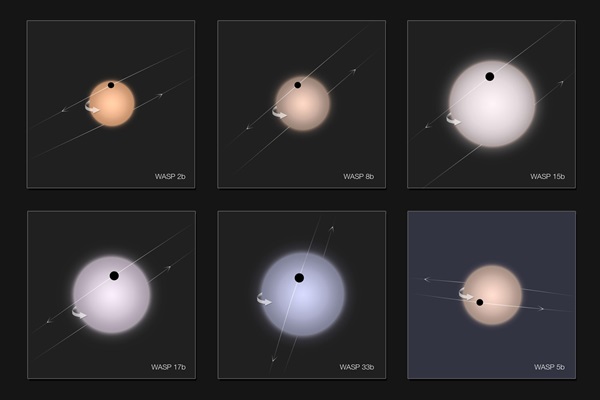Key Takeaways:
Scientists have announced the discovery of nine new transiting exoplanets. When they combined these new results with earlier observations of transiting exoplanets, astronomers were surprised to find that six out of a larger sample of 27 were orbiting in the opposite direction to the rotation of their host star — the exact reverse of what is seen in our own solar system. The new discoveries provide an unexpected and serious challenge to current theories of planet formation. They also suggest that systems with exoplanets of the type known as hot Jupiters are unlikely to contain earthlike planets. The new research was be presented in a paper by Andrew Collier Cameron of the University of St. Andrews at the Royal Astronomical Society National Astronomy Meeting (NAM 2010) in Glasgow on Tuesday.
“This is a real bomb we are dropping into the field of exoplanets,” said Amaury Triaud, a Ph.D. student at the Geneva Observatory who, with Cameron and Didier Queloz, leads a major part of the observational campaign.
Research indicated that planets form in the disk of gas and dust encircling a young star. This protoplanetary disk rotates in the same direction as the star itself, and up to now astronomers expected that planets that form from the disk would all orbit in more or less the same plane and that they would move along their orbits in the same direction as the star’s rotation. This is the case for the planets in the solar system.
After the initial detection of the transiting objects with the Wide Angle Search for Planets (WASP), the team of astronomers established their planetary nature and characterized the nine new exoplanets using the HARPS and CORALIE spectrographs on the 3.6-meter European Southern Observatory telescope and the Swiss Euler telescope at La Silla in Chile, the SOPHIE spectrograph at the Observatoire de Haute-Provence, and the FIES spectrograph on the Nordic Optical Telescope on the Canary Island of La Palma.
Surprisingly, when the team combined the new data with older observations, they found that more than half of all the hot Jupiters studied have orbits that are actually misaligned with the rotation axis of their parent stars. They even found that six exoplanets in this extended study (of which two are new discoveries) have retrograde motion: They orbit their star in the “wrong” direction.
“The new results really challenge the conventional wisdom that planets should always orbit in the same direction as their star’s spin,” said Cameron.
In the 15 years since the first hot Jupiters were discovered, their origin has been a puzzle. These are planets with masses similar to or greater than that of Jupiter, but that orbit very close to their suns. The cores of giant planets are thought to form from a mix of rock and ice particles found only in the cold outer reaches of planetary systems. Hot Jupiters must therefore form far from their star and subsequently migrate inward to orbits much closer to the parent star. Many astronomers believed this was due to gravitational interactions with the disk of dust from which they formed. This scenario takes place over a few million years and results in an orbit aligned with the rotation axis of the parent star. It would also allow earthlike rocky planets to form subsequently, but unfortunately it cannot account for the new observations.
To account for the new retrograde exoplanets, an alternative migration theory suggests that the proximity of hot Jupiters to their stars is not due to interactions with the dust disk at all, but to a slower evolution process involving a gravitational tug-of-war with more distant planetary or stellar companions over hundreds of millions of years. After these disturbances have bounced a giant exoplanet into a tilted and elongated orbit, it would suffer tidal friction, losing energy every time it swung close to the star. It would eventually become parked in a near circular, but randomly tilted, orbit close to the star. “A dramatic side effect of this process is that it would wipe out any other smaller earthlike planet in these systems,” said Queloz.
Two of the newly discovered retrograde planets have already been found to have more distant, massive companions that could potentially be the cause of the upset. These new results will trigger an intensive search for additional bodies in other planetary systems.










